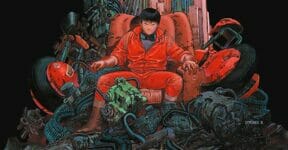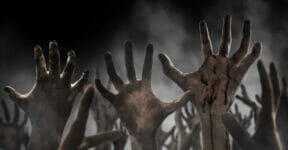A psychological thriller will always have its respectable place in the horror literature along with ghost, zombie, vampire, witch and monster stories alike. As of today, it seems like every angle of any scary tale has already been explored by various authors from different genres, but it does not mean that old stories can never spark a real fright. Take “Whispers” by Dean Koontz, for example; published in 1980, the novel is a classic horror fiction set in an unmistakably out-of-fashion world, yet it still delivers a fresh chill down the spine like real whispers in the dark.

While the premise is nothing peculiar in the landscape of psychological thriller, the clinging mystery behind every heart-thumping encounter between the characters keeps its puzzling elements to the end. It is a tight thriller in which a fresh Hollywood writer/director finds herself attacked in her house by an unknown man. But she has a gun, allowing her to escape the attack relatively unscathed. The unknown man doesn’t think he has enough of a warning, so he attacks again only to get killed with a knife, or so it seems. The unexpected scenes turn out to be just the start of a journey into a true nastiness.
Much of the story revolves around three main characters: Hillary Thomas, Tony Clemenza, and Bruno Frye. The first two individuals are the protagonists. Hillary is the writer/director, who at this point is already both a victim of assault and a survivor. A dark past of abuse is lingering in her soul and manifests itself in some irritating self-image problems. For long she has been fighting the ghosts of her alcoholic parents.
Tony Clemenza is a police officer and part-time painter with a fascinating talent for making good observations of the world. He is initially working on an unrelated case of a serial rapist before bumping into Hillary’s incident. He has two active investigations now but his partner, Frank Howard, is always ready to join the effort. Since Tony also suddenly harbors romantic feelings for Hillary, he needs his partner more than ever. Finally, Bruno Frye is the violent attacker and murderer shrouded in mystery.
The book introduces the fourth character Joshua Rhineheart in the later part of the story. He is a lawyer tasked with taking care of the Frye estate only to get dragged deep into the peculiarities of it all. He probably is the only person who has enough insights into the Frye family and knows the underlying dark truth underneath their public persona.
Whispers can be divided neatly into two sections. The first section explores the rather typical investigative efforts into the assault case involving all the main characters, whereas the second section delves deep into the more peculiar side of Bruno Frye. Think of the first section as a discussion about “the living” and take the second one as an insight into “the living dead” because Bruno isn’t dead yet.
A gripping episode of cat-and-mouse game between a terrifying rapist and an empowered woman under the protection of a cop who loves her offers quite an opening stretch. Tony wants to believe Hillary’s account of the attack, but his more pragmatic side makes it difficult to take everything she says at face value. It is like a damsel-in-distress situation, only in this case, the knight in shining armor wants to understand the full story first. As the novel moves to the second section, it introduces some intense gothic elements to the equation.
Love does its job well in between the plotlines. When Hillary and Tony finally do the deed, it creates such a powerful experience to keep the morale high despite every perplexing question they have about Bruno. More importantly, love builds a genuine connection between the characters. Hillary and Tony see love as something to share – a beautiful strength to maintain their sanity when darkness slithers and life is at stake. Bruno has a completely different opinion about it. The rapist can only understand love and sex both power struggle and violence.
Bruno’s tendency for violence is revealed as stemming from his inability to cope with all the bad influences exerted upon him by his twisted mother. It is then easy to draw a comparison between Bruno and Psycho’s Norman Bates just as soon as the story gets to this point. Both characters are entirely overwhelmed by their respective domineering mothers and possessed by an inclination to kill. The difference is that Bates kills people (men and women) so that no one else gets in the way of her cruel mother’s love, while Bruno does it so he can prevent his dead mother from going back to life and abusing him again.
The stories in the two novels are, however, far from similar. Both are memorable novels with proper characterizations and antagonists who wreak real havoc, but each delivers a thrilling tale of a different nature.
We think Whispers, just like most psychological thrillers, stands at its best when it allows the story to straddle the lines of horror, love, and supernatural. There are multiple plot points where you cannot help but wonder about the multiple possibilities of what is happening, which is a good thing in a mystery novel. Some elements of weirdness and actions also seem to always arrive at the right moments to keep the readers engaged.
What about you? Have you read Whisphers? If not then buy it here!
Other things you might want to know:
Screen adaptation:
The 1990 horror film “Whispers” is based on the novel. There was never a theatrical release, and instead the film went via Live Home Video in the United States. In 2012, it was re-released on DVD.
What are some known pen names used by Dean Koontz:
Aaron Wolfe
Brian Coffey
David Axton
Deanna Dwyer
John Hill
K.R. Dwyer
Leigh Nichols
Anthony North
Owen West
Richard Paige
Has the author written non-fiction works, too?
How to Write Best Selling Fiction (1981)
Writing Popular Fiction (1972)
A Big Little Life: A Memoir of a Joyful Dog Named Trixie (2009)
Check out other articles by month:







